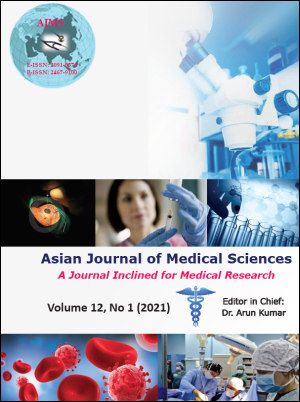Management of Distal Femoral fractures with Locking Compression Plate- A Prospective study
Keywords:
Distal Femoral Fractures, Open Reduction and Internal Fixation, Functional Outcome, Neer's ScoreAbstract
Background: Distal femoral fractures are one of the common type of fractures seen after motor vehicular accidents. The optimal management of these fractures requires open reduction and internal fixation by plates and screws. Various studies have shown that open reduction and internal fixation by plates and screws result in early post-operative knee mobilization which is essential for good union and better functional outcome.
Aims and Objective: The current study was conducted to evaluate the results of fracture lower end of femur treated by open reduction and internal fixation using locking compression plate.
Materials and Methods: This was a prospective clinical study in which the cases with fracture lower end of femur were included on the basis of a predefined inclusion and exclusion criteria. Fractures were categorised by Mullers classification. All patients were treated by distal femoral locking compression plates and screws. The cases were followed up for radiological union and functional outcome (Neer’s scoring). The statistical analysis was done using SSPS 21.0 software. P value less than 0.05 was taken as statistically significant.
Results: Out of the 20 studied cases there were 13 (65%) males and 7 (35%) females with a M:F ratio of 1:0.53. Road traffic accidents were the most common cause (75%) of distal femoral fractures. The most common type of fracture seen in studied cases was found to be Mullers C2 type of fracture (45%) followed by Mullers C3 (20%) and Mullers C1 (15%). All patients were treated by open reduction and internal fixation. Mean Injury to surgery interval was found to be 4.25 days in studied cases. Postoperatively desirable knee flexion (1100) was achieved in 10 (50%) cases whereas in 8 patients 910-1090knee flexion was achieved. In 2 (10%) patients less than 900 knee flexion could be achieved. The functional outcome (as assessed by Neer’s score) showed that Good and fair results were seen in 13 (65 %) and 6 (30 %) patients. Poor functional outcome was seen in only 1 (5 %) patient.
Conclusion: Locking compression plate is found to have good results in patients with traumatic distal femoral fractures in terms of early mobilization and functional outcome. Particularly in intra-articular fractures it provides good angular stability by its triangular reconstruction principle.
Downloads
Downloads
Published
How to Cite
Issue
Section
License
Authors who publish with this journal agree to the following terms:
- The journal holds copyright and publishes the work under a Creative Commons CC-BY-NC license that permits use, distribution and reprduction in any medium, provided the original work is properly cited and is not used for commercial purposes. The journal should be recognised as the original publisher of this work.
- Authors are able to enter into separate, additional contractual arrangements for the non-exclusive distribution of the journal's published version of the work (e.g., post it to an institutional repository or publish it in a book), with an acknowledgement of its initial publication in this journal.
- Authors are permitted and encouraged to post their work online (e.g., in institutional repositories or on their website) prior to and during the submission process, as it can lead to productive exchanges, as well as earlier and greater citation of published work (See The Effect of Open Access).




